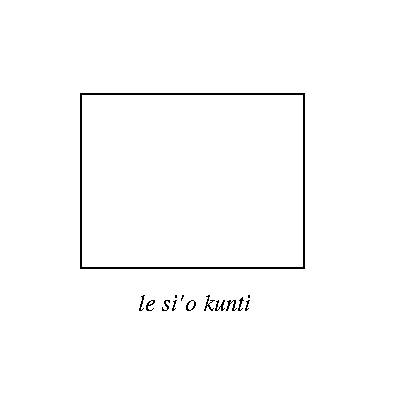The purpose of the feature of Lojban known as “abstraction” is to provide a means for taking whole bridi and packaging them up, as it were, into simple selbri. Syntactically, abstractions are very simple and uniform; semantically, they are rich and complex, with few features in common between one variety of abstraction and another. We will begin by discussing syntax without regard to semantics; as a result, the notion of abstraction may seem unmotivated at first. Bear with this difficulty until Section 11.2.
An abstraction selbri is formed by taking a full bridi and preceding it by any cmavo of selma'o NU. There are twelve such cmavo; they are known as “abstractors”. The bridi is closed by the elidable terminator kei, of selma'o KEI. Thus, to change the bridi
into an abstraction using nu, one of the members of selma'o NU, we change it into
The bridi may be a simple selbri, or it may have associated sumti, as here. It is important to beware of eliding kei improperly, as many of the common uses of abstraction selbri involve following them with words that would appear to be part of the abstraction if kei had been elided.
(Technically, kei is never necessary, because the elidable terminator vau that closes every bridi can substitute for it; however, kei is specific to abstractions, and using it is almost always clearer.)
The grammatical uses of an abstraction selbri are exactly the same as those of a simple brivla. In particular, abstraction selbri may be used as observatives, as in Example 11.2, or used in tanru:
| la | djan. | cu | nu | sonci | kei | djica | ||
| That-named | John | is-an | (event-of | being-a-soldier | ) | type-of | desirer. |
|
John wants to be a soldier. |
Abstraction selbri may also be used in descriptions, preceded by le (or any other member of selma'o LE):
We will most often use descriptions containing abstraction either at the end of a bridi, or just before the main selbri with its cu; in either of these circumstances, kei can normally be elided.
The place structure of an abstraction selbri depends on the particular abstractor, and will be explained individually in the following sections.
Note: In glosses of bridi within abstractions, the grammatical form used in the English changes. Thus, in the gloss of Example 11.2 we see “my going-to the store” rather than “I go-to the store”; likewise, in the glosses of Example 11.3 and Example 11.4 we see “being-a-soldier” rather than “is-a-soldier”. This procedure reflects the desire for more understandable glosses, and does not indicate any change in the Lojban form. A bridi is a bridi, and undergoes no change when it is used as part of an abstraction selbri.
